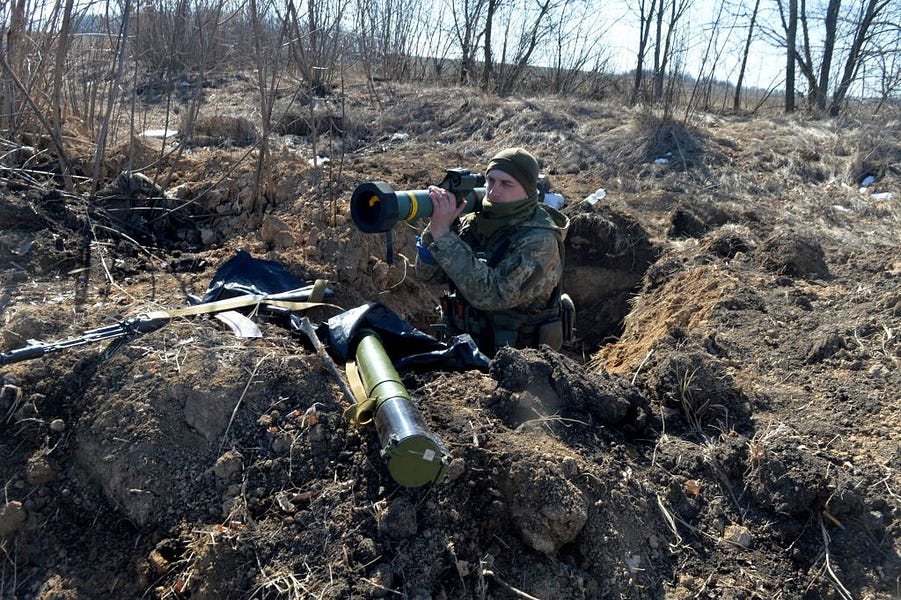With the Ukrainians, against the odds, having stymied Vladimir Putin’s not-so-special operation to quash their independence, it is time to expand Western military aid to give Ukraine what it needs to regain lost ground and establish the military conditions for a positive outcome in any negotiations to come. While the United States and its allies have done well thus far—U.S. stocks of man-portable anti-air and anti-armor weapons have been substantially drawn down—the questions now are more about quality than quantity. The current “operational pause” should be translated into a Ukrainian advantage, made into an opportunity not simply to continue to bleed the Russians but to prepare to defeat them soundly.
The first step is to recognize that time is tight. The current Russian offensive has “culminated”—this Clausewitzian term for “losing momentum” has officially entered the dictionary of punditry, no longer requiring further definition—and it is unclear whether the Russian army can reclaim any initiative beyond artillery and rocket bombardments. While the Russians are beginning to dig in and form some sort of defensive line, that will take time, manpower, sustained logistics, and other expensive efforts. Those happen to be all the qualities that have thus far been absent in Russia’s efforts. In sum, a “hunkering down” strategy is a risky approach for an obviously brittle force.
It also has begun to shift the tactical initiative to the Ukrainians. For the best part of the past week, the fighting has been characterized by Ukrainian counterattacks. To be sure, these have been smaller-scale and localized affairs, but they have been much more than hit-and-run raids; the Ukrainians have gained ground and retaken villages, and, thus far, been able to hold them. While it is impossible to judge from a distance or through the soda-straw views available on Twitter, it would appear that the Ukrainian command has been prudent and the operations well thought-out and controlled.
It is reasonable to think that this window for counteroffensives will be open for some time. The Russians lack the resources to create a Maginot Line-style barrier, and even if they did it would have huge gaps and be subject to both penetration and flanking maneuvers; as the ground dries out, larger formations will be less road-bound.
To take advantage of the opportunity they have won for themselves, the Ukrainian military needs five kinds of capabilities: greater direct firepower, more mobility, longer-range weapons (both artillery and air defense), operational logistics, and nimble command-and-control arrangements to manage a more fluid fight. The material makings of such a mobile Ukrainian corps are readily available. The world is awash in old Soviet T-64/T-72 tanks and BMP infantry vehicles of the sort the Ukrainians already have and are trained on, and in equivalent howitzers, rocket systems, and resupply vehicles. The Ukrainians have made effective use of the S-300 air defense systems they have (and which are also plentiful around the world) and could likely quickly integrate the newer and longer-range S-400. In sum, it is not impossible to imagine an element of the Ukrainian army that could suppress Russian artillery, penetrate or flank Russian prepared defenses, and deny Russia’s air force decisive air superiority.
It is the human dimension of a larger counteroffensive campaign that will be most challenging. The Ukrainians have thus far forced the Russians to fight the war the Ukrainians have planned for. And it might also be the case that the Ukrainians have planned for the moment when they could counterattack.
But a war of movement, even on an operational, campaign-level scale, is much more complex. It rewards intuition, improvisation, initiative, and risk-taking by subordinate commanders, the Clausewitzian coup d’oeil that defines battlefield situational awareness. The Ukrainians need not be Napoleon and his marshals—and their Russian opponents have been singularly deficient in these qualities thus far—but their reach must exceed their grasp. While the Ukrainians have got it right thus far, and so have reason to be confident they can rise to a new occasion, such operations would be a whole new ballgame for them.
Then there’s the tricky matter of logistics—another new ball game for the Ukrainians. All the things the Russians have failed to do—get gas, beans, and bullets to large and moving formations—the Ukrainian supply system would have to do to support a counteroffensive. Beyond bureaucratic incapacity, resupply convoys would be at risk from Russian artillery and air attack, though the Russians’ ability to strike targets other than air fields, opera houses, and apartment buildings is in doubt.
And here is where U.S. and Western advice—perhaps even provided by contractors—can make a difference beyond arranging for materiel. The current situation is not entirely dissimilar from the stalemate that marked the Balkans war circa 1995. That year, after a period of coaching from the U.S. firm MPRI (Military Professional Resources Incorporated), a group of consultants formed by former U.S. Army Chief of Staff Gen. Carl Vuono and U.S. Army Europe Commander Gen. Crosbie Saint, the Croatian army unleashed “Operation Storm,” which lifted the siege of Bihac in southern Bosnia and led to the collapse of the Serbian enclave of Krajina, destroying the Serb army there. This counteroffensive did much to shape the outcome of that war. The campaign was large—across a front of nearly 400 miles—and hugely successful—restoring about 4,000 square miles of Croatian territory—and it forged a lasting strategic victory. The success was far beyond what the Croat military had previously been capable of.
The United States and NATO could also indirectly support a Ukrainian campaign by conducting large-scale alliance exercises modeled on the annual Cold War “Reforger” (for “Return of Forces to Germany”) maneuvers across the Baltic states and eastern Poland this summer, diverting Russian attention and complicating Putin’s reinforcement arithmetic. Such exercises would not only signal Western resolve but begin to shake off decades of NATO operational rust and lost experience. It could also pave the way for a more coherent U.S. military posture in Europe.
The emerging battlefield pause in Ukraine gives the United States and its allies the opportunity not just to sustain Kyiv’s resistance but to enable Ukraine’s restoration to sovereignty and national independence and reward its aspirations to become a liberal democracy and outpost of European security. It is also an opportunity to rediscover the alliance’s original strategic purpose: containing Russian aggression until such time as there is regime change in Moscow.
It is important, too, for the Ukrainians, the United States, and NATO to get there “the fustest with the mostest”—which is not, in fact, a Nathan Bedford Forrest quote—when the storm breaks again. It may not be possible, in the foreseeable future, for Kyiv to reclaim the eastern Donbas or Crimea, but the more cards they can bring to any negotiating table, the better. Like most of Europe’s past long-running wars, this one seems destined to end in an uti possidetis deal, meaning you keep what you got for now, until the next round. While the Ukrainians have surprised us all so far and have the battlefield momentum, the territory they control does not make for a sustainable defense into the future, either on its own or within NATO and the EU. Ukraine has won true glory; it needs some true victories.
Giselle Donnelly is a senior fellow in foreign and defense policy studies at the American Enterprise Institute.






Please note that we at The Dispatch hold ourselves, our work, and our commenters to a higher standard than other places on the internet. We welcome comments that foster genuine debate or discussion—including comments critical of us or our work—but responses that include ad hominem attacks on fellow Dispatch members or are intended to stoke fear and anger may be moderated.
With your membership, you only have the ability to comment on The Morning Dispatch articles. Consider upgrading to join the conversation everywhere.